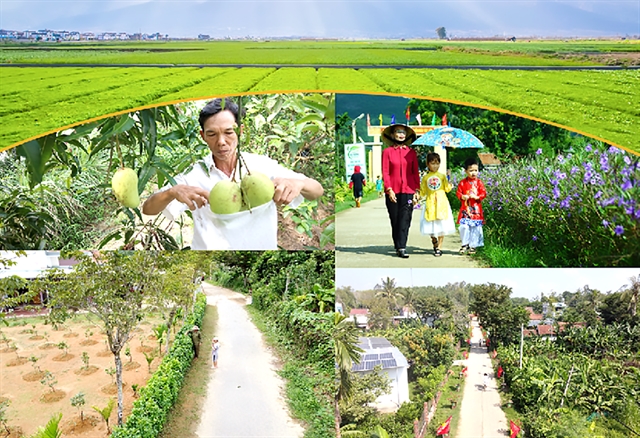 Society
Society

 |
By Tố Như
HÀ NỘI The disparity in results of building new-style rural areas between regions and provinces nationwide remains significant. Eliminating this gap is not an easy task.
The criteria for the new-style rural areas at all levels for the 2021-2026 period were issued and implemented from 2022. However, after a period of implementation, many localities reported that some indicators and criteria were not suitable for the practical situation in various regions.
Therefore, to ensure the feasibility of implementing the National Targeted Program on New Rural Development in different regions, a draft resolution stipulates that the government should review, amend and supplement the criteria and indicators in the New-style rural areas criteria at all levels to be in line with the practical situation. This includes the development and issuance of new-style rural areas criteria suitable for ethnic minority areas and mountainous regions, as outlined in Conclusion 65-KL/TW on the continued implementation of Resolution 24-NQ/TW on ethnic affairs in the new situation.
This is also a step in the roadmap to build new-style rural areas for the whole country, and especially for ethnic minority regions.
According to the National Coordination Office of the National Targeted Program on New Rural Developmentt, the current status reveals that in the midland and northern mountainous region, 966 out of 2,019 communes (47.8 per cent) meet the standards of New-style rural areas. This marks a notable increase of 11.5 per cent compared to the figures at the end of 2020. Notably, among these communes, 147 have attained advanced New-style rural areas standards, reflecting a surge of 135 communes from the end of 2020, while 13 communes have reached model new-style rural areas standards, showcasing an increase of 10 communes from the same period.
However, regional disparities persist, evident in the Red River Delta achieving a 100 per cent compliance rate, the Southeast region at 91.4 per cent, and the northern mountainous region reaching only 47.8 per cent. The Central Highlands region also exhibits a compliance rate of 59.7 per cent. Notably, four provinces in the northern mountainous region still fall below the benchmark with a commune standard rate below 30 per cent.
The count of communes, particularly those facing unique challenges in ethnic minority and mountainous regions, coastal zones, and islands, acknowledged for meeting the New-style rural areas standards remains quite restricted. Remarkably, none of the districts listed as economically disadvantaged have attained recognition for meeting the new-style rural areas standards up to this point.
Lê Thị Lý, Deputy Head of the Department of Agriculture and Rural Development in Vĩnh Tường district, Vĩnh Phúc province, highlighted that, in alignment with the updated New-style rural areas criteria for districts introduced by the government, the district currently satisfies only 6 out of the 9 specified criteria. Furthermore, among the communes that have achieved advanced new-style rural area standards, several criteria still remain unfulfilled.
In terms of environmental criteria, certain localities exhibit numerous deficiencies and non-compliance with regulations in waste classification at the source, as well as in the processes of waste collection and transportation. Lý pointed out that achieving a requirement of over 65 percent of households using clean water from centralised water supply systems is crucial. However, there are still communes lacking centralised domestic water supply systems.
Furthermore, the communes currently undergoing upgrades to meet New-style rural areas standards encounter significant challenges in sustaining achievements related to infrastructure, transportation, irrigation, and production organisation. This is primarily due to a shortage of investment funds in various essential areas.
According to the Central Coordination Office for New Rural Development, in terms of budget allocation and planning for the 5-year period 2021-2025, the Ministry of Agriculture and Rural Development (MARD), in coordination with the Ministry of Planning and Investment, the Ministry of Finance, and related ministries, has completed the submission of the authorised body to allocate VNĐ32 trillion for the mid-term investment plan for the 2021-2025 period (including VNĐ30 trillion for domestic capital investment and VNĐ2 trillion for foreign capital for localities according to the provisions of the State Budget Law, the Public Investment Law, and relevant regulations).
 |
| A gap in new-style rural area construction still exists between regions. VNA/VNS Photo |
In accordance with Government Decree 38/2023/NĐ-CP dated June 24, 2023, MARD has now drafted an estimated capital document for the central budget to implement the programme in 2024 and the following two years for central ministries, sectors and provinces directly under the central government. This allows localities to be more proactive in budget allocation from the central budget, allocate matching funds from local budgets, and mobilise other sources of funding for implementation.
During the process of monitoring the implementation of national target programmes, some localities have raised concerns that implementing some conclusions of the State Audit will affect the legitimate rights and interests of the people, as well as the agencies and organisations involved in implementing national target programmes.
Therefore, the draft resolution stipulates that the State Audit participate with the government in researching and proposing special mechanisms to handle some recommendations related to the implementation of State Audit conclusions on the recovery of funds, and refund of state budgets to protect the legitimate rights and interests of the people and organisations in implementing national target programmes.
Deputy Minister of Agriculture and Rural Development, Trần Thanh Nam, emphasised that the National Targeted Program on New Rural Development is an ongoing initiative, as the criteria are consistently refined over time. Initially, localities strive to meet the standards of New-style rural areas, and now, numerous communes that have achieved this status are progressing towards advanced and model new-style rural areas.
In the implementation of these criteria, it is essential for localities to continually assess the equilibrium between accomplished results and investment costs. Nam also stressed the importance of anticipating potential consequences and impacts on mountainous and rural areas, as well as vulnerable households, in order to devise and implement solutions that align with the current situation.
To ensure the development of the National Targeted Program on New Rural Development in the next phase, with substantial and effective development in line with the set goals, Nam proposes that localities continue to strengthen propaganda and mobilise people to actively contribute to building new-style rural areas voluntarily. Effectively implementing credit policies for investment in agriculture and rural areas and striving to shorten the gap in building new-style rural areas between localities is also important.
The goal is to have at least 90 per cent of communes nationwide meeting new-style rural areas standards by 2026; 70 per cent of districts, towns and cities directly under the province complete the task of building New-style rural areas.
It is necessary to effectively integrate the use of state budget support and various resources. The involvement and contributions of the people must be genuinely voluntary, based on democratic discussions without excessive pressure on the people.
Currently, many areas with large land funds can convert from inefficient forest planting or low-value crops to planting large, high-value timber trees or converting to fruit tree models (pomelo, orange, pear, jackfruit, mango), at the same time, investing in raw material areas, transportation routes and irrigation systems. Also, in terms of the economy, it is necessary to promote agricultural and handicraft production activities, with a focus on the One Commune One Product (OCOP) programme, aiming to contribute to promoting traditional specialty products of each region and increasing the income of the people associated with exploiting the potential of rural tourism in disadvantaged areas.
With comprehensive solutions regarding increasing investment sources, supporting the transformation of the rural economic model and solutions regarding personnel, the programme on building new-style countryside in difficult areas and ethnic minority areas will have many bright spots, gradually catching up with the progress of the national New-style rural areas building programme in the future. VNS